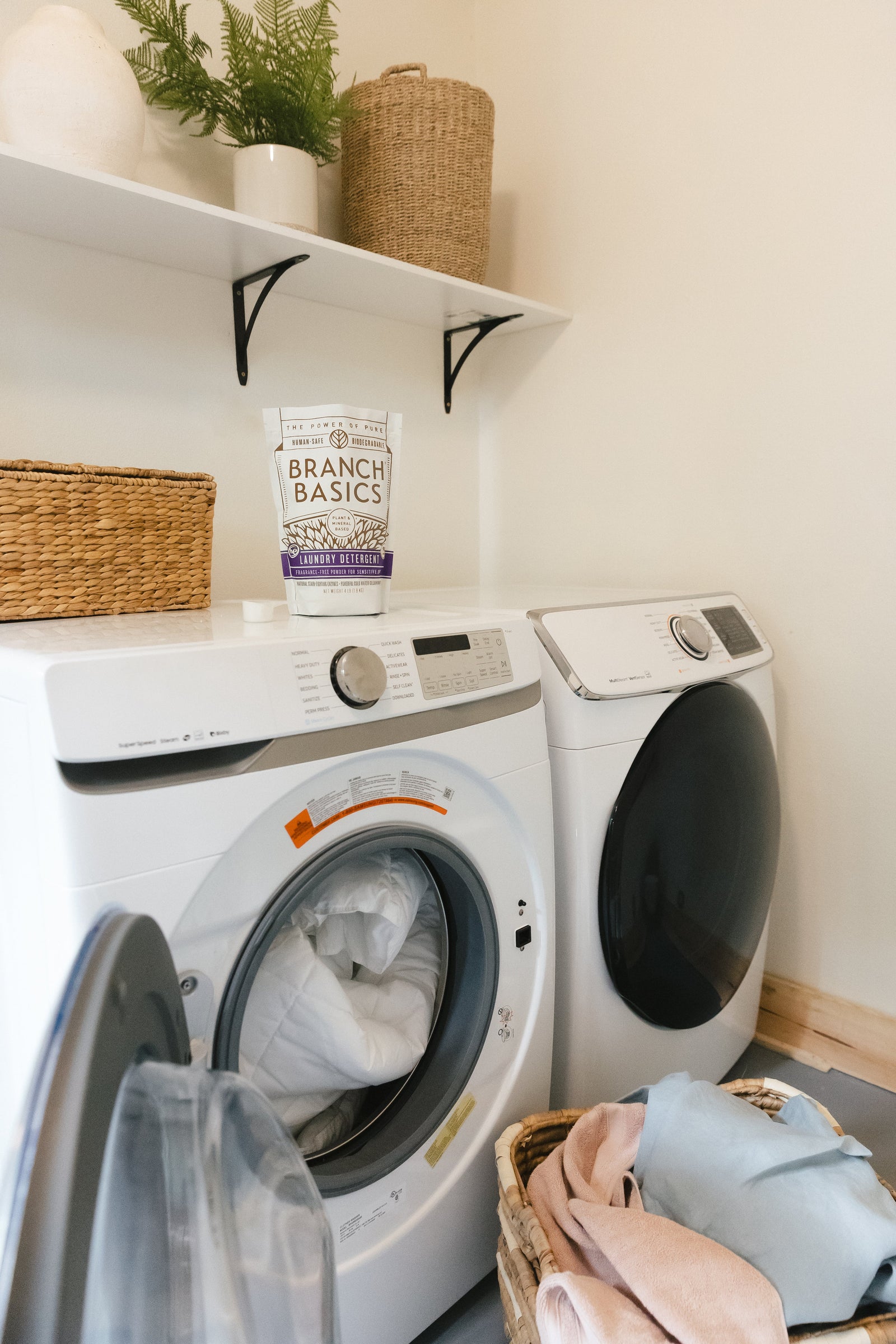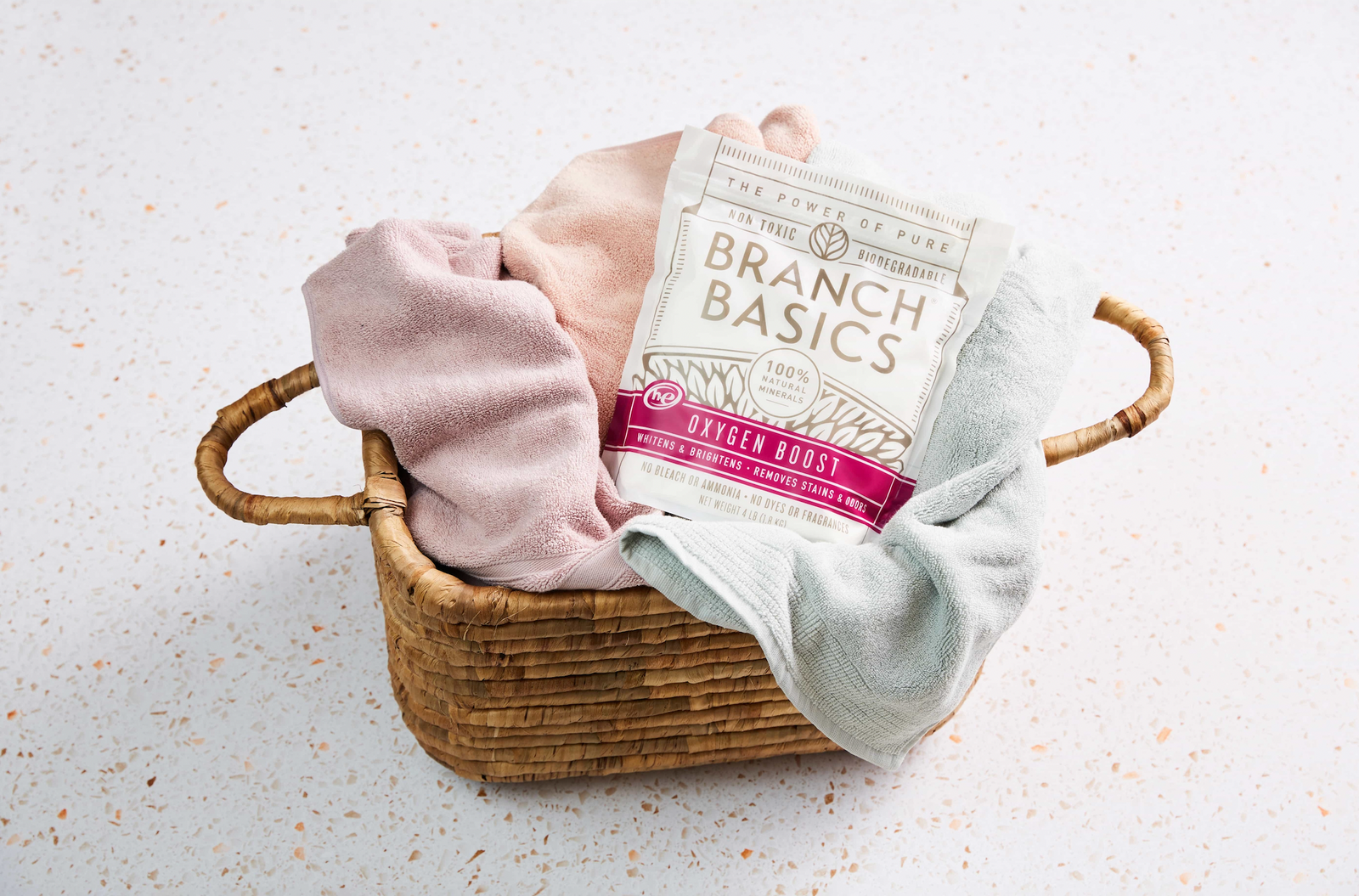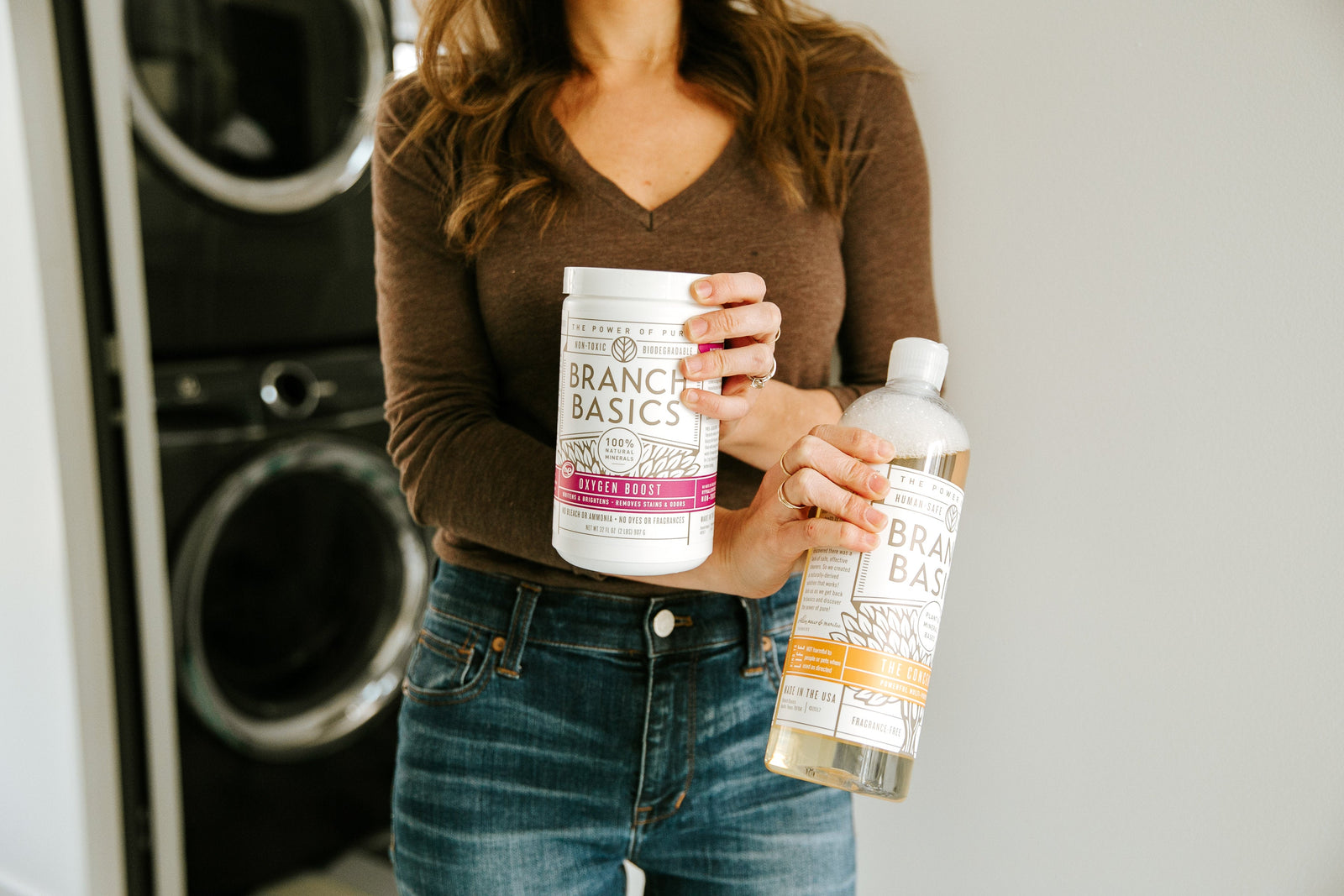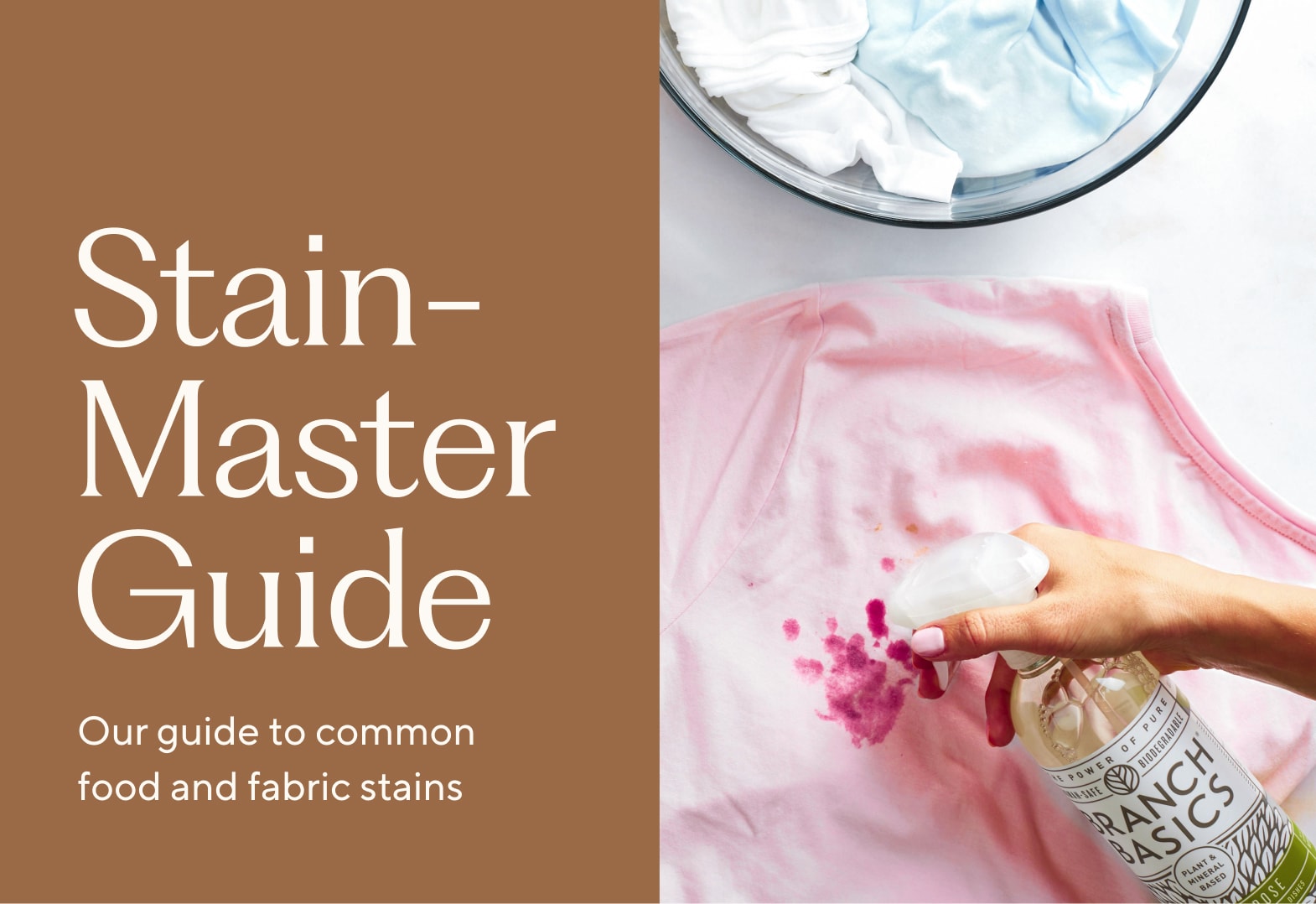6 Safe Laundry Room Essentials: A Complete Checklist

Did you know the laundry room is often the most toxic room in the average American home?
That’s because most of us have been led to believe we need a laundry laboratory of synthetic chemicals to clean, disinfect, de-wrinkle, deodorize, add scent, and care for our clothing.
These synthetic chemicals include things like: chlorine bleach, carcinogenic VOCs (volatile organic compounds) and SVOCs (semi-volatile organic compounds), endocrine-disrupting phthalates, and hundreds upon hundreds of undisclosed fragrance chemicals.
Fortunately, it’s never been easier to toss laundry products with harmful ingredients in favor of human-safe laundry products.
This article will share exactly which human-safe laundry essentials you need to create cleaner clothes, a greener environment, and a healthier home.
First, What Does “Human-Safe” Mean?
Although greenwashing (the practice of making products look safer and more sustainable than they are) is prevalent in the laundry business, it’s not difficult to identify a toxic laundry product.
The first step is to look for toxic red flags on the label:
- No ingredient list
- Indication that the product is fragranced
- Labeled “Unscented” which means synthetic masking chemicals are used
- “Warning”
- “Danger”
If you see those words on the box or bottle, you know that the product contains harmful synthetic chemicals.
Additionally, be on the lookout for statements like “Eye, Skin, or Lung Irritant.” Most of the time, these words indicate a toxicity issue.
Finally, simple callouts a label is not enough! Just because a laundry product is labeled or marketed as “green,” “unscented,” “fragrance free”, “plant-based,” or “made with botanical extracts” doesn’t mean it’s necessarily safe.
We recommend products that are MADE SAFE certified or use EWG Skin Deep to help you vet the ingredients in your products. They have a rating system of one (the safest) to ten (the most toxic).
We recommend that all ingredients in products kept in your home be rated a 1 or 2 on EWG Skin Deep.
Why Have a Human-Safe Laundry Room? Is It Possible?
Creating a human-safe laundry room is one of the best ways to improve your home's indoor air quality.
That’s because synthetic laundry chemicals don’t typically stay in the laundry room.
Thanks to HVAC systems, a lack of ventilation, and clogged-up dryer vents, these volatile chemicals are circulated throughout the home through the air and the SVOCs in products ride on household dust.
They also find their way into the outside environment via dryer vents (you know, that clean-laundry smell that wafts through neighborhoods) and waterways, where they cause air pollution and harm to fish and aquatic life.
Washing synthetic clothing, for example, is one of the major contributors to our microplastic problem.
If all this information about your trusted laundry products is disheartening, please know you’re not alone. After all, nearly all of us grew up believing laundry products were safe, pleasant, and healthy.
It’s even normal to have an attachment to certain toxic laundry scents because aside from the powerful emotions smells can naturally invoke, these synthetic scents are designed to elicit a physical and emotional addictive-response.
However, this information should also serve as inspiration to start creating the human-safe laundry room you, your family, and our planet deserve (and yes, it is possible to do so).
Our List of Human-Safe Laundry Room Must-Haves
If you’re into simplifying your life, you’ll LOVE creating a human-safe laundry room.
With just a few affordable staples, you’ll have everything you need to clean, deodorize, disinfect, de-wrinkle, and soften your clothes.
Let’s take a look at the human-safe laundry essentials.
1. Laundry Detergent Alternatives
First thing is first, to clean your clothes, you need an effective, human-safe laundry detergent.
Commercial laundry detergents contain an absolutely frightening cocktail of chemicals, including:
-
Synthetic fragrances are considered one of the top five allergens and can trigger asthma attacks.
1 The Environmental Working Group has also found that 75% of the fragrances contain phthalates2 (pronounced “thal-ates”), which have been linked to diabetes, obesity, and hormone disruption which affects both development and fertility. - Optical brighteners are chemicals that leave a light-reflecting residue on the clothes so they appear brighter. Many people develop skin irritation and rashes from exposure to optical brighteners, and they can increase photosensitivity. Plus, they are toxic to fish and cause bacterial mutations.
- Nonylphenol Ethoxylates (NPEs), these nonionic surfactant petrochemicals are banned in Canada and the European Union, but are still found in American detergents. NPEs are endocrine disruptors that adversely affect physical function and fetal development. Infants and children are especially vulnerable to these chemicals, which are known to adversely affect neurologic, immune, cardiac, kidney, and liver function as well.
- Bleach, aka sodium hypochlorite, is involved in more household poisonings than any other chemical. Plus, it and other synthetic cleaning chemicals react to generate chlorinated VOCs, which are very toxic and are considered human carcinogens.
- And many more!
We discuss a complete list of hazardous synthetic laundry detergent chemicals in How To Toss Your Toxic Laundry Detergent, but you get the point!
What To Use Instead:
Look for human-safe, soap- and mineral-based laundry detergents, like Branch Basics Laundry Detergent. Our human-safe laundry detergent comes in powder form and puts your health first. It contains no synthetic chemicals or fragrances and works like the pure laundry powders of yesteryear.
It can be used in all types of washing machines and complements other natural whiteners and fabric softeners.
2. Human-Safe Whiteners & Stain Removers
We’ve already discussed the toxicity issues surrounding chlorine bleach, one of the most common chemicals used for whitening, brightening, and stain removal.
Not only are bleach and other synthetic chemical-based stain removers dangerous, but they’re also completely unnecessary when you know how to remove stains naturally.
Our Human-Safe Stain Remover Product Recommendations
Two powerhouse products that remove stains and brighten your clothes are:
- Oxygen Boost—a plant and mineral-based laundry booster you can add to your washing machine and use directly on stains in combination with Branch Basics All Purpose.
- Laundry Detergent —a powerful powdered that removes stains and odors with just one scoop for convenience and ease.
For more advice, check out:
- Human-Safe Laundry Stripping With Branch Basics
- How To Get Stains Out Of Everything With Branch Basics The Complete Guide
DIY Stain Removers and Whiteners
There are also excellent DIY options for stain removal and whitening…most of which you probably already have sitting in your laundry room or pantry.
Some options include:
- Distilled white vinegar contains acetic acid, which has a bleach-like effect on clothing. To use, add half a cup of vinegar to the final rinse for brighter, whiter, softer clothes.
- Baking soda can be added directly to your washer to brighten clothing. It can also be used as a paste to remove various stains.
- Hydrogen peroxide makes a perfect alternative to chlorine bleach for stain removal on white fabric. You can add one cup to your wash to brighten whites or add directly to whites to remove stains (works great on reusable menstrual pads!).
- Salt is a secret weapon that works on various stains, even red wine and blood. You typically mix it with a bit of water to form a paste or dump a big clump on a stain and let it dwell.
We share more information on these and other DIY stain removers and brighteners in 7 Human-Safe and Environmentally Safe Alternatives To Bleach.
3. Wool Dryer Balls
Did you know that over 70% of dryer sheet brands received a “D” or an “F” for safety from the Environmental Working Group.
The human-safe swap for this laundry room essential is wool dryer balls.
These work to naturally reduce static and soften clothing in the dryer, reduce drying time by up to 25%, and they last forever.
To learn more about the benefits of Wool Dryer Balls and how to use them, check out: Wool Dryer Balls Gift From The Happiest Sheep To You!
4. DIY Vinegar Cleaner for Your Washer & Dryer
Washers and dryers—especially mold-prone front-loaders—need to be cleaned as part of preventative maintenance.
Typically, bleach is recommended for this purpose. However, just swap distilled white vinegar in place of bleach 1:1 and run a self-clean cycle.
Contact the manufacturer if you’re unsure about using distilled white vinegar.
For more detailed instructions on cleaning your washer and dryer, check out: How To Clean And Detoxify Your Washer And Dryer and 5 Tips For Preventing Mold And Mildew In Your Front Loader.
5. Guppy Friend Bags For Synthetic Clothing
Guppyfriend Washing Bags are a tool for reducing microplastic pollution from laundering synthetic clothing.
Just toss your clothing into the bag and run laundry as usual.
And (side note), consider wearing natural-fiber clothing as much as possible for the sake of your health and that of the environment.
6. Clothes Drying Rack
Air-drying clothing is a great way to save energy, preserve the life of your clothing, and cut down on dust from your laundry vent.
There are tons of racks to choose from, like this over-the-door model for small spaces, folding racks for indoors or full-on clothesline racks for your yard.
We discuss more about air drying clothes in How to Wash Dry-Clean-Only Items At Home.
A Few Tips for Detoxing Your Laundry Habits
Transitioning to a human-safe laundry routine need not be stressful or overwhelming. Just take a box and remove laundry products with harmful ingredients.
Replace your conventional laundry products with human-safe options, like Branch Basics Laundry Detergent or Branch Basics Concentrate and Oxygen Boost. Instead of fabric softener and dryer sheets use wool dryer balls.
There you go! You will have eliminated most synthetic laundry chemicals in your home by doing just those two things. Easy, right?
Want to go deeper?
Try swapping out bleach for hydrogen peroxide or distilled white vinegar, and download our stain guide and start learning how to remove stains without synthetic chemicals. Before you know it, you’ll have tossed all the toxins in your laundry room and dramatically improved your home’s indoor air quality.
Need Help Tossing the Toxins in Your Laundry Room?
We have lots of resources for that!
The best place to start is to check out our online course: Toss The Toxins Category 2: Cleaning Products & Laundry tutorial. Our co-founder, Marilee Nelson, will take you through how to detoxify your laundry room step-by-step.
And be sure to check out our Trial Kit for stains, our Laundry Kit (with optional glass Laundry bottle), Laundry Detergent, and our Starter Kit.

Marilee Nelson
Marilee Nelson is an Environmental Toxins expert who has spent nearly 30 years advocating for the chemically-sensitive and chronically-ill. She is a Board Certified Nutritionist, Certified Bau-Biologist and Bau-Biology Inspector and specializes in Food As Medicine. She has helped thousands of families and individuals identify, heal and recover from toxic exposures and is on a mission to revolutionize the way American families view their health.








